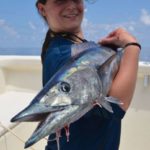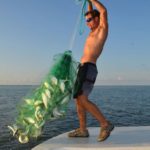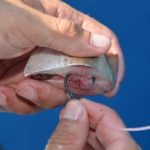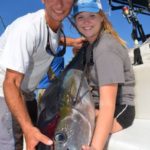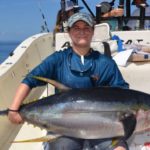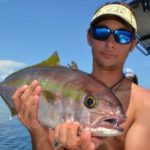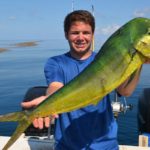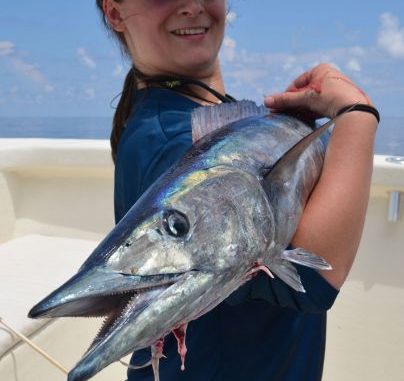
A crew of young fishermen featured in this magazine in 2000 have grown up — and moved from the canals of Metairie to offshore in their fishing pursuits.
They’re baaack!
Five years ago Louisiana Sportsman ran a feature story about a gang of school kids who caught scads of fish from Metairie drainage canals right in the heart of the New Orleans metropolitan area.
They reminded most readers (with any gray on their heads) of The Little Rascals, the series of comedy movie shorts produced between 1922 and 1944, and endlessly re-released in the years following.
The 220-film series told the tale of a bunch of average neighborhood kids and their adventures. Most of them were boys, but from 1935 to 1941, the cast had a leading lady named Darla.
The oldest member of the “Our Fishing Gang” group featured in this magazine was an 18-year-old high school senior named Mitch Rogers.
The “Darla” of the gang was his saucy twin sister Angelle Rogers.
Well, they’re all growed up now and in college.
In fact, Mitch will be graduating soon with a degree in business administration, which he plans to put to use when he expands his current part-time job as an offshore fishing guide into a full-time occupation.
The Rogers twins invited me to go fishing with them again, this time in the blue waters of the Gulf of Mexico rather than to green waters of the canals of Metairie.
And for this trip, instead of bream, bass, Rio Grande cichlids, alligator gar, and carp, we would be chasing tunas, snappers, jacks, wahoo and dolphin.
Mitch’s Louisiana Offshore Adventures (504-881-0117) is based out of Venice. Accompanying the pair were another member of Our Fishing Gang: Trey Adams (brother Zach didn’t make the trip), Mitch’s girlfriend Rebecca Brown and Kaitlyn Guillatte, a friend of Angelle’s.
Chaperoning all this young blood was an old salt — Bob England, a 52-year-old, semi-retired upland hunting guide who splits time between Arnett, Okla., and living aboard his 48-foot sportfisher moored in Cypress Cove Marina.
England owned the 31-foot AmeraCat catamaran Mitch has leased for charter fishing.
It looked to be a gorgeous day. As daw was cracking, Mitch powered the boat out Red Pass, swung left and headed to near Table Top Rig set close to outside of the west bank of Southwest Pass. Here Mitch planned to cast net for live bait.
“I don’t know why, but (pogies) are always close to the Table Top,” he murmured.
The lean young man turned the boat’s controls over to Bob and mounted the bow deck to pitch the big cast net. After a series of water hauls, Mitch signaled directions to Bob to sneak the boat up on a big school of the fish, properly called menhaden but always referred to as pogies in Louisiana.
His next cast yielded the mother of all hauls, but they were a little on the large side to suit Mitch’s taste. A little more hand-signaling got the boat up on a school of medium-sized fish more to Mitch’s liking.
All hands scrambled to get the delicate creatures in the livewell before they died.
With bait secured, the young charter captain shot the boat around the end of Southwest Pass and headed south-southeast. His destination was 48 miles away in Mississippi Canyon’s Block 547.
The catamaran sliced through a dense weed line of sargassum floating in the azure waters. I must have been drooling, thinking of all the brilliant dolphin cavorting under it because Mitch yelled, “No time for that now. I want to use the pogies while they are still alive to target tuna.”
Two huge, floating drilling platforms loomed larger and larger. Mitch slowed down at the nearer one, ENSCO 8503. It was in 2,850 feet of water. The farther floater was the “Who Dat Rig.”
After the boat stopped, Bob and the young skipper quickly rigged two lines. Using 6/0 circle hooks, one hooked a pogie through the shoulder and the other hooked a baitfish through the mouth and out the upper jaw.
The hooks were tied with uni knots to 15 feet of 60-pound-test fluorocarbon leader tied uni knot to uni knot to 80-pound-test PowerPro braided line.
After the hooked pogies were gently tossed overboard, 50 yards of line was hand stripped from one reel, while 75 to 100 yards was dragged off the other.
“Stripping line directly from the reel is a no-no,” Bob cautioned. “Rather, put the rod in a holder and strip the line downward from the rod’s tip: You want any fish that hits to pull the line from your hand.”
Stripping from the reel, Mitch added, can result in a loop that can snag on a reel handle. Something as minor as an errant puff of wind can cause such a loop.
The boat sat quietly in the water, motor off and drifting. The young skipper explained that fishing with live pogies was different than using hardtails for bait.
With hardtails, the boat is “bump-trolled” — kicked in and out of gear to keep it moving slowly.
“Bump-trolling kills pogies, and they just come to the surface,” Mitch explained.
With the two live-bait lines (aka “livies”) out, Angelle and Bob set out a chunk line, one rigged similarly to the livies but with a chunk of freshly cut pogie on the hook.
The technique to use in baiting the chunk line hook, Bob explained, is to shove the blunt side of the circle hook into the bait rather than hooking the bait on with the point of the hook.
“You want the hook to slip easily out of the bait when it is reeled in,” he said. “If the bait stays on the hook, it twists the line. Then the next drift line will be loopy.”
The chunk line also was tended more closely than were the livies. Bob constantly stripped small amounts of line off the reel to keep the line from becoming taut, which would make the bait drift unnaturally.
The first tuna smacked the chunk line.
Mitch grabbed the rod and shoved it into his girlfriend’s stomach. The brawling yellowfin quickly had Rebecca groaning and screaming.
hen her arm muscles began to twitch, Kaitlyn subbed her on the rod.
“I don’t think I can do it,” Rebecca wailed before assuming the rod again.
Then Mitch spelled her; then she went back on the rod.
“Oh, you really need to work out to do this,” Rebecca cried.
Finally, sweating profusely, Rebecca brought the yellowfin tuna to the surface. But when the gaff neared it, it immediately dove.
“Oh, no, no, no,” she yelled.
Mitch stepped in again and brought the fish to the surface before shoving the rod to her again.
He was determined that his girlfriend see how much fun his job is.
The yellowfin tuna sported three hooks, all located in the same corner of its mouth — others had hooked this fish, and not too long ago.
Mitch ran the boat back to the same side of the rig that produced the bite, and he and Bob set out three chunk lines.
This drift produced a respectable blackfin tuna Kaitlyn promptly dispatched.
As soon as the lines went back out, another bait was nabbed by a fish. Angelle rushed to take her turn on the rod.
Halfway in, the stubborn fish pulled off the hook.
The pint-sized dynamo (she’s 5-foot, 1-inch “on a good day”) visibly wilted.
“That’s depressing,” Angelle sighed.
With three chunk lines back out, Mitch began slinging cut pogie pieces as chum in an attempt to spur fish activity. It seemed like the silver chunks were visible forever as they slowly sank in the unbelievably clear, cobalt blue of the sea.
The routine was repetitive — drift, reel up, drift, reel up.
The next bite went to Trey, who was disappointed with his catch — a bonita (aka little tunney) destined for use as cut bait.
Bob asked the anglers to reel up. He went to the controls and moved the boat upcurrent and farther away from the rig.
“You get too close, you get barracuda and bonita,” he explained.
This obviously wasn’t Bob’s first rodeo.
“The first time I fished out of Venice was 14 years ago,” he confirmed. “I kind of got hooked on it.”
He and Mitch made a good team.
By this time five other boats — three charter and two private vessels — were on the rig, and the activity seemed to cause a slackening of the bite.
“Let’s try the livies again,” Mitch said.
He circled the boat halfway back to the rig and set two lines off the stern. He followed this up by throwing live pogies into the area where the baited hooks were.
Bob set out a chunk line baited with a big piece of cut bonito while Mitch chummed.
The chunk line went sizzling off the reel. Angelle grabbed the rod with a vengeance born of frustration from losing her first fish.
The pint-sized dynamo hung on the rod for dear life as the fish stripped line from the reel.
Mitch tried coaching his sister, but pumping and cranking were hard for her. The fish was having its way early in the fight.
“That’s a good fish,” Bob observed. “Someone get a harness for her.”
Mitch tried to resume coaching, but like a good sibling Angelle resisted.
Her brother tried reaching in a couple of times to take the rod.
“No! No! No!” she screamed, “My fish!”
The fish surged under the boat’s motors. Mitch reached in forcibly and pulled the rod from Angelle’s belt, at the same time shouting for Bob to jack the outboard motors.
As the fish cleared the motors, Angelle immediately jumped to take back the rod. She begged for the harness that hadn’t come to her yet.
“No,” Mitch replied. “That’s how we almost lost this fish.”
“Please give me a harness,” she begged.
“No!” Mitch replied. “You’re not going to get it.”
“You can tell they are brother and sister,” chuckled Bob, who was standing to one side watching.
Finally the fish surfaced and Mitch expertly gaffed it on its first pass near the boat.
Angelle staggered away, dropping to her knees coughing. She rose, wobbled her way around the cockpit to the other side of the boat, leaned over the gunnel and retched for five minutes.
Then she dropped into a heap on the deck.
“She’s done for,” I thought.
Mitch repeated the drift several times, but in spite of schools of yellowfin and blackfin tuna smashing baitfish at the water’s surface around the big floater, they couldn’t get a taker.
None of the other boats were doing any better.
The midday sun was blistering hot. Rebecca and Trey had retreated to the island of shade provided by the boat’s T-top and gave up on anything involving exertion.
They began to fiddle with their cell phones.
“Wahoo! Wahoo!” Mitch suddenly screamed.
The swimming torpedo shot under the boat from the stern toward the bow.
And, guess what? On the bow was the indestructible Angelle, vigorously pitching a blue popper with a heavy saltwater spinning reel.
The wahoo went straight to her popper and crushed it.
Luck of the gods! One set of treble hooks hooked the fish in the mouth, but the other set snagged under its throat below the gill covers, keeping the 30-pound-test, leaderless line away from the wahoo’s viscous arsenal of teeth.
The siblings did their brother-sister twin thing again.
Angelle got excited and yelled — loud!
Mitch, with more fishing experience as a charter captain tried coaching, again.
She resisted — vocally.
They got the fish.
Mitch, a little reluctantly, turned his back on the big floating rig and headed toward the weed line the boat ran through that morning. But he had another trick up his sleeve.
He stopped the boat at “Moxie,” a fixed-leg platform in Block 365 of the Mississippi Canyon area.
Because of the great depth of water the platform sits in — 660 feet — Mitch dragged out a heavy weapon, a Krystal Fishing electric reel.
It was a cannon, spooled with 300-pound-test braided line and rigged with a four-hook gear equipped with 11/0 circle hooks. A 5-pound weight was on the bottom of the gear.
He was looking for a grouper — a big one.
He didn’t end up getting that species, but he did catch an oddity — banded rudderfish.
Actually, he caught four of them, and all were just barely under the legal maximum size limit of 22 inches fork length.
Big enough to eat; small enough to keep.
When they got to the weed line, they trolled its edge at 6 mph with ballyhoos and ILander trolling lures, and were rewarded with colorful action.
In the water, the dolphin looked like electric blue streaks as they dashed out of the sargassum to hit the lures.
It was exciting, with everyone shouting and pointing.
“There’s one!”
“Wow!”
“Lookit that!”
“Another hit!”
Bob added to the action by periodically casting a well-chewed-up Frenzy Popper, which the dolphin seemed to adore.
The blue-flecked green-and-gold fish flashed like jewelry as they came over the rail.
In the midst of the action, Bob murmured something to Mitch in a low voice, who in turn asked the group if they wanted to catch some red snapper on the way in.
Apparently Bob had been doing well at a particular platform in the West Delta area and the fish were big.
Only eight miles from Southwest Pass, it was in state-claimed waters and fair game. It didn’t take long to prove Bob right. Within an hour, they added 14 huge red snappers to their bag. The smallest one weighed 12 pounds.
Everyone seemed contented on the ride in.
I hunkered down on a bean bag behind the cockpit and reflected on the day’s catch: two good yellowfin tuna, a blackfin tuna, a wahoo, four banded rudderfish, a passel of dolphin and a big pile of red snapper meat.
Pretty good for city ditch fishing kids.
What was there not to like?
